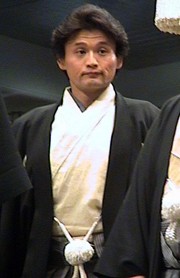| Yokozuna Comparisons Joe Kuroda |

 |
| Amateur Sumo's Global Aspirations Courtesy: International Sumo Federation |

 |
| Rikishi of Old Joe Kuroda |

 |
| Heya Peek Barbara Ann Klein |

 |
| SFM Interview Mark Buckton |

 |
| Sumo 101 Barbara Ann Klein |

 |
| Photo Bonanza See the Haru |
 |
| Haru Basho Review Lon Howard |

 |
| Lower Division Rikishi Mikko Mattila |

 |
| Natsu Basho Forecast Mark Buckton |

 |
| Kimarite Focus Mikko Mattila |

 |
| Sumo in Print Mark Buckton |

 |
| Kokugi Connections Todd Lambert |

 |
| Fan Debate Facilitator – Lon Howard |

 |
| SFM Cartoons Benny Loh & Stephen Thompson |

 |
| Let’s Hear From You What was it that |

 |
| Readers’ Letters See what some |

 |
Sumo Quiz
The Quizmaster
Answer the Qs and win yourself next basho’s banzuke.
Le yokozuna Takanohana établit rapidement toute une série de records de précocité à mesure qu'il gravissait les échelons :
 Yusho makushita : 16 ans et 9 mois
Yusho makushita : 16 ans et 9 mois Promotion en juryo : 17 ans et deux mois
Promotion en juryo : 17 ans et deux mois Promotion en makuuchi : 17 ans et 8 mois
Promotion en makuuchi : 17 ans et 8 mois Premier sansho : 18 ans et 7 mois
Premier sansho : 18 ans et 7 mois Première Kinboshi : 18 ans et 11 mois
Première Kinboshi : 18 ans et 11 mois Promotion comme komusubi : 18 ans et 11 mois
Promotion comme komusubi : 18 ans et 11 mois Promotion comme sekiwake : 19 ans et 1 mois
Promotion comme sekiwake : 19 ans et 1 mois Yusho makuuchi 19 ans et 5 mois (Asashoryu a remporté son premier yusho à 22 ans et un mois)
Yusho makuuchi 19 ans et 5 mois (Asashoryu a remporté son premier yusho à 22 ans et un mois) Promotion comme ozeki : 20 ans et 5 mois
Promotion comme ozeki : 20 ans et 5 mois
Takanohana (photo de Barbara Ann Klein)
De mars 1993 à novembre 1997, Takanohana remporta le yusho ou son équivalent 21 fois et fut second 5 fois. Durant cet intervalle il ne connut qu'un make-koshi au basho de novembre 1993 et un kyujo au
En janvier 2003, Takanohana se retira et se vit attribuer un ichidai toshiyori (seuls trois yokozuna, Taiho, Kitanoumi et Chiyonofuji se virent accorder un tel toshiyori pour leurs performances éclatantes sur le dohyo comme yokozuna. Taiho a depuis pris sa retraite de la Kyokai et officie comme directeur du Musée du Sumo. Actuellement seuls Kitanoumi et Takanohana possèdent un ichidai toshiyori. Chiyonofuji le refusa puisqu'il envisageait déjà d'hériter du titre de Kokonoe oyakata à la place).
Takanohana hérita officiellement de la Futagoyama-beya paternelle, et la rebaptisa en Takanohana-beya le 1er juin 2004. Son père et shisho, l'ancien ozeki Takanohana, devenu Futagoyama oyakata, travailla d'arrache-pied comme membre du conseil d'administration de la Kyokai pour accroître la popularité de l'ozumo. Futagoyama oyakata mourut le 30 mai 2005 d'un cancer de la bouche, et Takanohana fit le vœu de reprendre son héritage en travaillant pour la Kyokai, même s'il n'a pas de responsabilités dirigeantes pour l'instant. Bien plus mince qu'il ne l'était pendant sa période active sur le dohyo où son poids avoisinait les 150 kilos,
Suite
